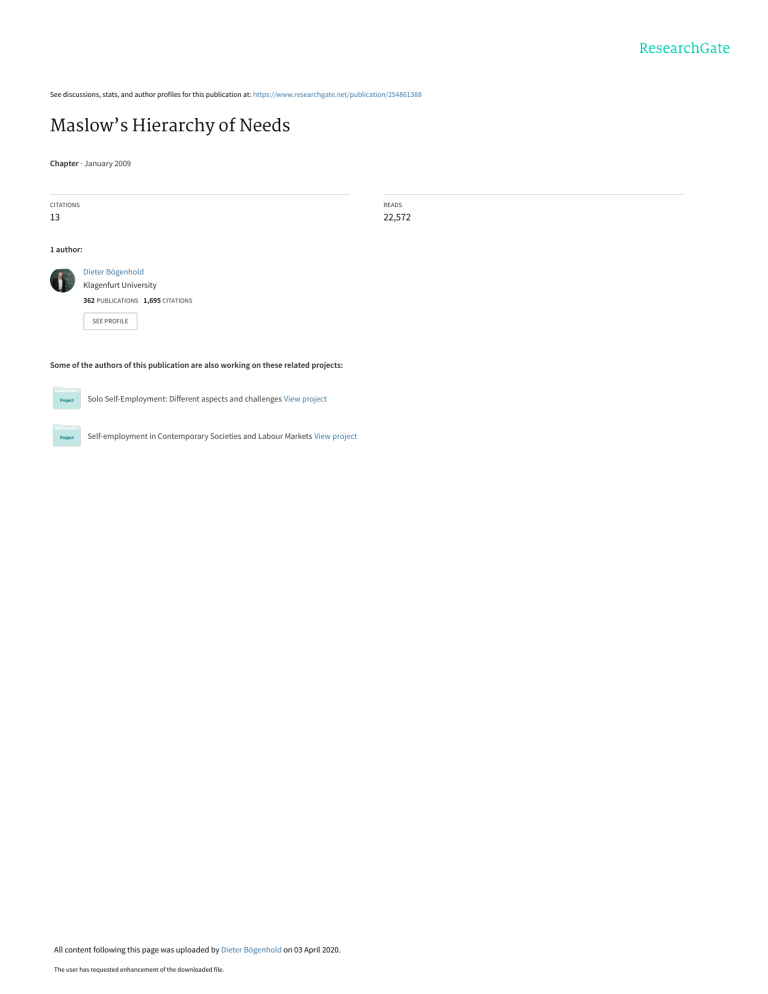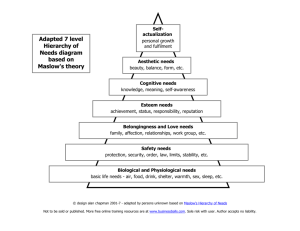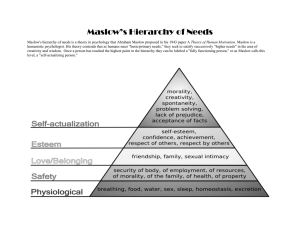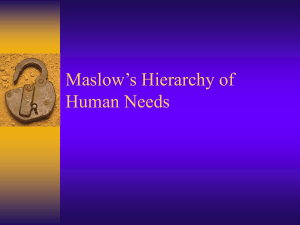
See discussions, stats, and author profiles for this publication at: https://www.researchgate.net/publication/254861388 Maslow’s Hierarchy of Needs Chapter · January 2009 CITATIONS READS 13 22,572 1 author: Dieter Bögenhold Klagenfurt Unìversity 362 PUBLICATIONS 1,695 CITATIONS SEE PROFILE Some of the authors of this publication are also working on these related projects: Solo Self-Employment: Different aspects and challenges View project Self-employment in Contemporary Societies and Labour Markets View project All content following this page was uploaded by Dieter Bögenhold on 03 April 2020. The user has requested enhancement of the downloaded file. Maslow’s Hierarchy of Needs Unfinished Business of Culture,” Accounting, Organisations and Society (v.30/1, 2005); G. Hofstede, Culture’s Consequences: International Differences in Work-Related Values (SAGE, 1984); G. Hofstede, Cultures and Organisations: Software of the Mind (HarperCollins, 1994); G. Hofstede et al., Masculinity and Femininity: The Taboo Dimension of National Cultures (SAGE, 1998), B. McSweeney, “Hofstede’s Model of National Cultural Differences and Consequences: A Triumph of Faith—A Failure of Analysis,” Human Relations (v.55/1, 2002). Jenny K. Rodriguez University of Strathclyde Maslow’s Hierarchy of Needs One of the well-known complaints about the limitations of economics is that economic theorizing is often based upon unquestioned assumptions about the nature of human agents. The model of homo oeconomicus has often been taken as an abstraction of human behavior in order to highlight major rules of economic functioning in a simplified way. A fundamental problem is that homo oeconomicus’ underlying assumptions clash increasingly with everyday experiences by observers inspired by social sciences like psychology or sociology. According to these assumptions, human agents are isolated from social networks and they are reduced to rational calculating machines following ultimately egoistic aims of maximizing individual profit. The sterile world that operates with ideas of a homo oeconomicus takes motivation as granted and treats human behavior as a black box. In contrast, the primary aim of psychology is to ask for forces, grades, and types of motivation. Abraham H. Maslow (1908–70), a psychologist, offers a systematized typology of human needs that are organized hierarchically and that operate as motivation incentives at different levels. Maslow’s work has a prominent place within the academic area of psychology but is also very well known by a wide field of neighboring disciplines concerned with questions of needs and motivation. His book Motivation and Personality (1954) reads as an address not only to psychologists 1095 but also a plea to refer more systematically to a concept of meaning in science: A psychological interpretation of science begins with the acute realization that science is a human creation, rather than an autonomous, nonhuman, or per se “thing” with intrinsic rules of its own. Its origins are in human motives, its goals are human goals, and it is created, renewed, and maintained by human beings. Its laws, organization, and articulation rests not only on the nature of the reality that it discovers, but also on the nature of the human nature that does the discovering. Maslow inspired a new school of thought in academic psychology that tried to establish a platform beside behavioristic and psychoanalytic approaches and that was coined humanistic psychology. The approach had clear proximity to phenomenological thought and was distant to methods employing large data sets. Maslow’s taxonomy of needs serves as textbook knowledge still today and it is basic introduction in courses on management training or personal development. Initially, Maslow suggested five stages of needs that were later further developed to seven and finally eight stages. The first edition of Motivation and Personality (1954) summarized Maslow’s work undertaken between 1943 and 1954. Maslow’s hierarchy of needs has been often misunderstood as a very strict corset by which “higher” needs only come into discussion when “lower” needs are already satisfied “but actually it is not nearly so rigid as we may have implied.” Distinguishing between higher and lower needs means that lower needs are—anthropologically viewed—basic needs that cover physiological necessities such as getting or having food and shelter but also warmth, sexuality, and sleep. Maslow argues that even physiological needs can be ordered in a subhierarchy. On the other side, a higher need signals a later phyletic or evolutionary development. The need for food is shared by all living entities whereas the need for love or self-actualization is shared by fewer species. Another point is that higher needs are later ontogenetic developments. In Maslow’s hierarchy model the first and lowest stage of needs is represented by those biological and physiological needs whereas the second stage represents safety needs as provided through stability, 1096 Maternity Leave protection, and security. Maslow’s idea is that a firm order, laws, and limits belong to this area of safeness. The third stage of Maslow’s introduced needs represents love needs and belongingness needs that aim at affected and emotional inclusion of human beings into categories such as family, work groups, partnerships, or further social relationships. Esteem needs represent the fourth stage of Maslow’s hierarchy. Here, self-esteem, mastery, or independence are listed as well as status dominance, prestige, or managerial responsibility. With the third and fourth stages, Maslow proves to include clearly more sociopsychological dimensions into his framework of thought that regards human beings as being part of a social context and belonging to a social matrix of relations. The fifth stage, finally, is in line with those stages before: it is the level of self-actualization needs. By those needs, motivation for self-fulfillment is addressed. Realizing one’s individual personal potential, seeking personal growth and personal aims, and collecting one’s own experiences are moments that belong to this type of needs at the top of the hierarchy pyramid. The principle of hierarchy organization is that the higher the need, the less imperative it is for sheer survival, and the longer gratification can be postponed. Maslow argues in line with psychometric and psychomotoric findings that meeting with higher need levels means greater biological efficiency, greater longevity, less disease, better sleep and appetite and he says that psychosomatic researchers proved to find out that anxiety, fear, lack of love, or domination tend to encourage physical as well as undesirable psychological results, whereas higher need gratifications have survival value and growth value as well. Higher need gratifications result in better subjective results, e.g., more profound happiness. Maslow’s hierarchy of needs is led by a conceptualization of human beings that is not unidimensional. Later Maslow added further dimensions as cognition, aesthetic, and transcendence. Although Maslow’s hierarchy of needs is primarily developed by conceptual reflection, the attempt is far from being abstract. Maslow sheds light on human motivation and different sources of needs as they are very often neglected in economic models where human incentives are reduced to principles of homo oeconomicus. All that has been learned by human relations theory in management research and organization theory is fitting View publication stats well with Maslow’s thought. As more differentiated and wealthy societies and organizations prove to be, intrinsic motivation is increasingly becoming a major source of organization and restructuring. Even current voices in leading international economics are going to refer explicitly for a better understanding of motivation and are matching with some pieces of principle thought provided by Maslow. Motivation and Personality is not only a book by a psychologist for psychologists but it is of interest for all social scientists. The argumentation is based upon broad knowledge of the division of science. Maslow reads as presenting his hierarchy of needs primarily as a heuristic scheme knowing that this scheme has to be modified according concrete societies. Even in the beginning of his study, Maslow expresses that sociology matters: The study of the sociology of science and of scientists deserves more attention than it is now getting. If scientists are determined in part by cultural variables, then so also are the products of these scientists ... these are questions of the type that must be asked and answered for fuller understanding of the “contaminating” effect of culture upon perception of nature. During the last 50 years, Maslow has emerged as a classic for different academic disciplines. See Also: Consumer Needs and Wants; Empowerment; Motivation. Bibliography. Steven J. Hanley and Steven C. Abell, “Maslow and Relatedness: Creating an Interpersonal Model of Self-Actualization,” Journal of Humanistic Psychology (v.42/4, 2002); Abraham H. Maslow, Motivation and Personality (Harper & Row, 1954). Dieter Bögenhold Free University of Bolzano Maternity Leave Maternity leave is a job-protected leave from employment provided to mothers around the time of child-




